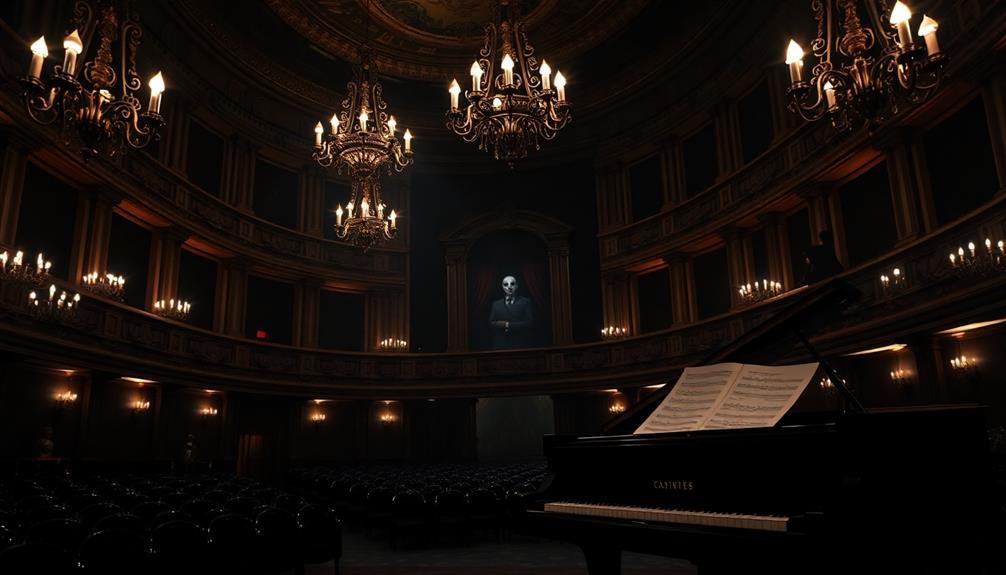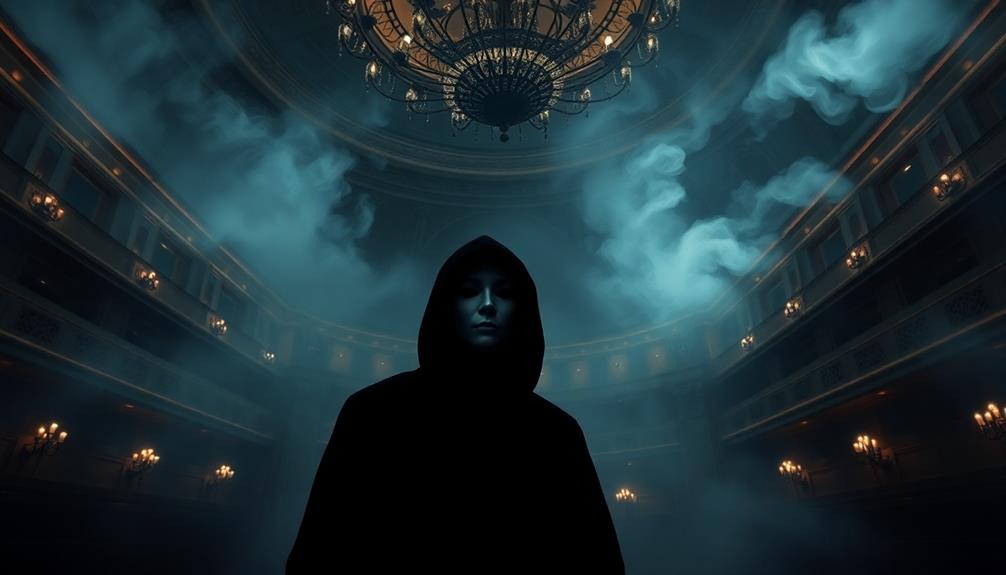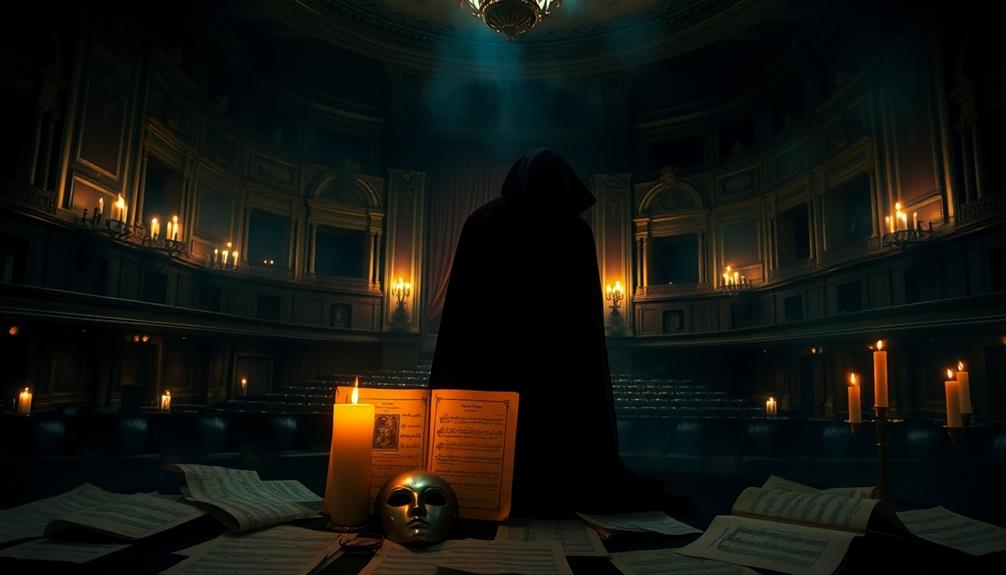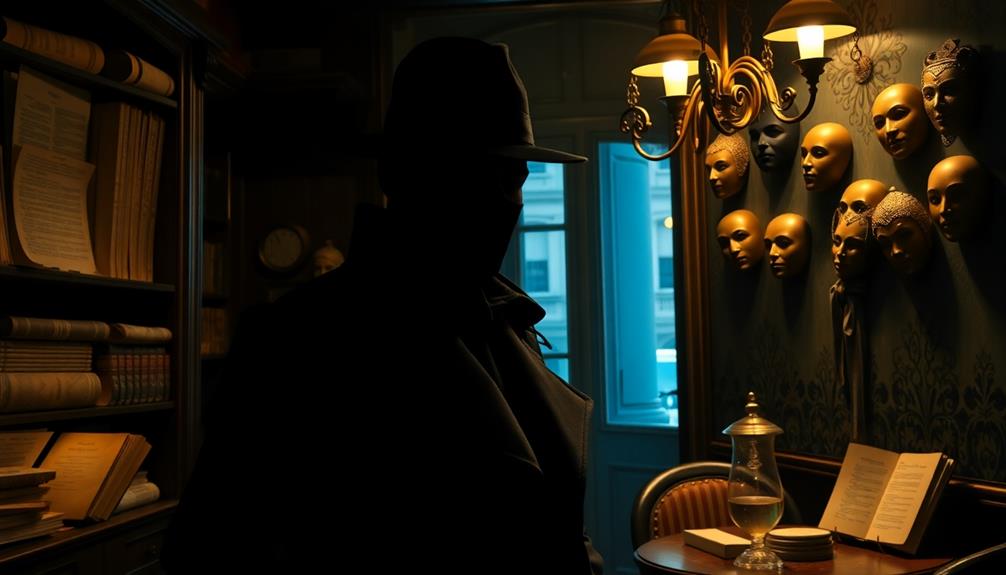Gaston Leroux, born in 1868 in Paris, shifted from law to journalism, enhancing his storytelling skills. His fascination with the supernatural and real-life events, like the tragic chandelier accident at Palais Garnier, inspired him to write *The Phantom of the Opera*. Through rich Gothic elements, he explored complex themes of obsession and love, showcasing intense character dynamics, especially between Christine, Erik, and Raoul. Leroux's narrative captivates audiences and has influenced countless adaptations, creating a lasting cultural impact. There's much more to discover about his life and work, so keep exploring to uncover the depths of this literary genius.
Gaston Leroux's Early Life
Although Gaston Leroux was born into a well-off merchant family in Paris on May 6, 1868, his journey was anything but ordinary.
Initially, you might think he'd follow the path of law, but Leroux quickly changed direction and dove into journalism. He worked as a court reporter and theater critic, where he sharpened his storytelling skills and developed a keen fascination for the arts.
Writing for publications like L'Écho de Paris, he immersed himself in the vibrant world of theater, absorbing its nuances and emotional depth. His experiences paralleled the intricate plots found in historical fiction set in Victorian England, where riveting mysteries of Victorian London often enthralled the readers.
These experiences as a theater critic greatly influenced his writing style, allowing him to weave operatic elements into his narratives. You can see this influence in his most famous work, *The Phantom of the Opera*, where the dramatic flair and theatricality shine through.
Inspiration Behind the Novel
Gaston Leroux's imaginative genius drew heavily from real-life events and legends surrounding the Palais Garnier opera house, shaping the haunting narrative of *The Phantom of the Opera*. His passion for storytelling intertwined with actual tragedies, giving depth to characters like Christine Daaé and Erik, the enigmatic Phantom.
The urban landscape of the opera house mirrors the struggles and complexities of the characters' lives, much like the depiction of early 20th-century Brooklyn in *A Tree Grows in Brooklyn* where resilience amidst adversity is a recurring theme resilience and growth amid adversity.
Here are some key inspirations that fueled Leroux's creativity:
- The tragic chandelier accident of 1896 at the Palais Garnier, which resulted in fatalities and injuries.
- Real-life figures, such as Swedish soprano Christina Nilsson and ballerina Nanine Dorival, likely influenced the character of Christine Daaé.
- Leroux's fascination with the supernatural, as he sought to prove the existence of ghosts, infused the novel with an eerie atmosphere.
- The underground lake beneath the opera house, a practical feature, became Erik's lair, enhancing the Gothic horror elements.
- Historical rivalries and tragic love stories, like that of Boismaison and Dorival, provided a backdrop for themes of jealousy and obsession.
These elements combined to create a rich tapestry of intrigue and emotion, making Leroux's work a timeless exploration of love, fear, and the macabre.
Overview of The Phantom of the Opera

In *The Phantom of the Opera*, you'll find a rich tapestry of Gothic elements that heighten the story's tension and mystery.
The haunting setting of the Paris Opera, with its atmospheric descriptions and labyrinthine corridors, enhances the overall ambiance.
The intense themes of obsession and love drive the characters, particularly Erik's fixation on Christine and the resulting turmoil with Raoul.
This complex interplay not only shapes the narrative but also leaves a lasting impact on readers and audiences alike.
Gothic Elements in Narrative
Set against the haunting backdrop of the Palais Garnier opera house, *The Phantom of the Opera* masterfully weaves Gothic elements into its narrative.
You'll find a rich tapestry of darkness, suspense, and emotion that defines the genre of Gothic literature. This story is filled with:
- Dark, atmospheric settings that enhance horror
- Supernatural elements like the ghostly Phantom, Erik
- Themes of isolation and madness reflecting psychological horror
- Rich imagery and symbolism that pull you in
- Music as a vital motif that foreshadows and evokes emotions
As you explore Erik's character, you'll feel the weight of his isolation and the madness that stems from it.
The supernatural elements contribute to the tension, leaving you questioning what's real and what's not.
You'll also notice how music plays a significant role, echoing the characters' emotions and driving the plot forward.
While the narrative is steeped in psychological horror, Leroux cleverly interjects moments of humor, balancing the grim atmosphere with lighter touches.
This blend of elements creates an unforgettable experience that keeps you captivated throughout the tale.
Themes of Obsession and Love
One of the most striking themes in *The Phantom of the Opera* is obsession, vividly embodied in Erik's overwhelming love for Christine Daaé. This deep fixation drives Erik to extreme actions, including kidnapping and violence, showcasing how love can transform into a dark obsession.
In contrast, Christine's relationship with Raoul represents a more nurturing form of love, highlighting the duality of affection—one that can be both life-affirming and destructive.
Erik's tragic backstory as a disfigured genius, shunned by society, adds layers to his character and evokes both fear and sympathy. His unreciprocated love leads him down a path of madness, revealing how obsession can warp one's reality.
As the narrative unfolds, you see how Erik's heartbreak culminates in despair, illustrating the moral ambiguities within relationships.
Leroux masterfully portrays love as a complex interplay of beauty and monstrosity, inviting you to question the true nature of love itself. In *The Phantom of the Opera*, love isn't just a feeling—it's a force that can drive individuals to extremes, forcing you to ponder the fine line between passion and madness.
Main Characters and Their Dynamics
The intricate relationships among Christine Daaé, Erik (the Phantom), and Raoul de Chagny form the heart of "The Phantom of the Opera."
You'll find that Christine's talent and emotional struggles drive the narrative, as she navigates her feelings for both the disfigured genius Erik and her childhood friend Raoul.
The love triangle creates a fascinating dynamic, showcasing the contrasts between obsession and compassion.
This interplay of character motivations mirrors the complexities found in Gothic literature, where themes of jealousy, power dynamics, and psychological depth often emerge, creating a rich tapestry of human emotion and conflict.
The dynamics among these characters can be further understood through the lens of Gothic storytelling's influence, as their interactions evoke the haunting atmosphere characteristic of the genre.
- Christine Daaé: A gifted soprano caught between two worlds, she embodies the struggle between love and loyalty.
- Erik: The Phantom's obsession with Christine leads to manipulation and violence, revealing his inner turmoil and desperation.
- Raoul de Chagny: Representing societal norms, Raoul's pursuit of Christine contrasts sharply with Erik's darker inclinations.
- Love Triangle: The dynamics between these three characters explore themes of unrequited love and jealousy.
- Madame Giry: As a link to Erik's past, she provides vital insights that deepen the narrative's complexity.
These characters' interactions reveal the moral ambiguities and emotional conflicts that make the story so compelling, leaving you captivated by their fates.
Key Themes and Motifs

In *The Phantom of the Opera*, themes of obsession and unrequited love drive the narrative forward, pulling you into the emotional turmoil of the characters. Erik's intense fixation on Christine showcases the destructive nature of obsession, leading to tragic outcomes. This mirrors the breakdown of societal norms seen in *Lord of the Flies*, where the absence of order reveals the darker sides of human nature.
You see the stark contrast between beauty and deformity, with Christine embodying ideal beauty while Erik's physical disfigurement symbolizes societal rejection and inner turmoil. This duality creates a haunting tension throughout the story.
Isolation is another prominent theme, as Erik's underground lair represents his emotional and physical separation from the world. Christine also battles her own feelings of entrapment, torn between the Phantom's dark allure and Raoul's love. Their struggles illustrate the pervasive sense of loneliness that permeates the tale, akin to the chaos that ensues in the absence of societal constraints.
Redemption and moral ambiguity are intricately woven into Erik's character arc. As he oscillates between villainy and vulnerability, you're prompted to contemplate the nature of monstrosity and the potential for change.
These themes compel you to reflect on the complexities of love, beauty, and the human condition, making Leroux's work both timeless and thought-provoking.
The Role of Music
Throughout *The Phantom of the Opera*, music emerges as an essential force that shapes the characters' journeys and the narrative's emotional landscape. This critical symbol reflects the characters' emotions and foreshadows key events, particularly in the intense relationship between Christine and Erik.
As a former theater critic, Gaston Leroux infuses the story with operatic elements, showcasing how music can manipulate and express vulnerability.
Here are some key aspects of music in the novel:
- The Phantom's obsession with music drives him to insist Christine sing in the opera.
- Erik believes Christine is the only one worthy of his musical legacy.
- Musical references highlight the tragic love between Erik and Christine, paralleling Gounod's Faust.
- The tension in their relationship is enhanced by specific musical pieces throughout the narrative.
- Music serves as a tool for both manipulation and deep emotional expression, illustrating beauty intertwined with monstrosity.
Ultimately, Leroux's use of music elevates the emotional stakes, allowing you to explore the depths of love and sacrifice that define the characters' lives.
Adaptations Over the Years

You'll find that *The Phantom of the Opera* has inspired a wide array of adaptations, from classic films to modern musicals. Each version brings its own twist to the Phantom's character, reflecting changing cultural norms and audience expectations.
The story's enduring legacy can also be seen in how it captivates audiences in ways similar to Agatha Christie's works, such as her renowned mystery, timeless classic *Murder on the Orient Express*.
Let's explore how these interpretations have shaped the story's enduring legacy.
Film Interpretations and Variations
Film adaptations of *The Phantom of the Opera* have captivated audiences for nearly a century, transforming Gaston Leroux's haunting tale into various interpretations that resonate with different generations.
The first film, a silent version released in 1925, showcased Lon Chaney's groundbreaking makeup and iconic visuals, setting the stage for future adaptations.
Throughout the years, filmmakers have drawn from Leroux's novel while injecting their unique spins, leading to fascinating character evolution.
Significantly, Andrew Lloyd Webber's 1986 musical adaptation paved the way for the 2004 film starring Gerard Butler, which offered a romanticized interpretation of the Phantom.
Here are some key highlights of these film adaptations:
- The 1943 version portrayed a more sympathetic Phantom, emphasizing his tragic backstory.
- The 1925 silent film became a classic for its haunting atmosphere.
- Late 20th and early 21st-century adaptations explored various genres, from horror to comedy.
- The character of the Phantom often appears more romantically appealing, deviating from Leroux's monstrous depiction.
- These interpretations reflect changing societal attitudes toward beauty and empathy, enriching the story's legacy.
Musical Adaptation Impact
Since its premiere in 1986, Andrew Lloyd Webber's musical adaptation of *The Phantom of the Opera* has profoundly influenced the way audiences perceive the story and its characters.
By transforming Leroux's original narrative into a Broadway stage phenomenon, the musical redefined the Phantom's character, shifting him from a darker figure to a more romanticized version. This change not only altered the story's tone but also impacted public perception, making the Phantom a beloved cultural icon.
The musical's global popularity skyrocketed, leading to performances in over 30 countries and translations into multiple languages.
Songs like "The Music of the Night" and "All I Ask of You" became instant classics, further solidifying the musical's place in theater history. The 2004 film adaptation, directed by Joel Schumacher, expanded the audience even further, grossing over $150 million worldwide and introducing the story to a new generation.
Ultimately, Andrew Lloyd Webber's musical didn't just revive Leroux's tale; it created a lasting legacy that continues to inspire adaptations and interpretations, making the Phantom a timeless figure in popular culture.
Cultural Reinterpretations and Trends
Cultural reinterpretations of *The Phantom of the Opera* showcase the story's adaptability and its ability to resonate with diverse audiences over the years. From Gaston Leroux's original tale, the themes of love and isolation have been reimagined in various forms, transforming Erik from a mere horror figure into a complex character whose story often highlights the romantic spectacle at its core.
Consider these notable adaptations:
- Andrew Lloyd Webber's 1986 musical: Reinvented the Phantom as a tragic romantic figure and became a Broadway sensation.
- 1925 silent film: Lon Chaney's portrayal established Erik as a visual archetype, cementing his status as a horror icon.
- 2004 film starring Gerard Butler: Offered a more sympathetic view of the Phantom, appealing to modern sensibilities about beauty and monstrosity.
- 1943 film adaptation: Explored themes of love and isolation, resonating deeply with contemporary audiences.
- 2010 musical *Love Never Dies*: Served as a sequel, further exploring the complexities of the love story between Christine and Erik.
These adaptations reflect changing societal attitudes and continue to breathe new life into Leroux's classic narrative.
Cultural Impact and Legacy
The legacy of *The Phantom of the Opera* is nothing short of remarkable, evidenced by its influence across various artistic mediums. Since Gaston Leroux penned this mystery novel, it has inspired over 50 film adaptations, countless stage productions, and numerous musical interpretations, solidifying its place in literary history.
Andrew Lloyd Webber's adaptation, first performed in 1986, has become the longest-running show in Broadway history, amplifying the cultural legacy of the story and introducing it to new generations. The Gothic elements of Leroux's narrative echo the rich tapestry of Southern history explored in works like *Gone With the Wind*, where personal struggles unfold against a backdrop of societal upheaval, showcasing resilience and growth in times of conflict interplay of personal struggles.
The novel has sold millions of copies worldwide, remaining a cornerstone of Gothic literature while influencing the horror and romantic fiction genres. The character of the Phantom has transformed into a cultural icon, often portrayed as a tragic romantic figure. These adaptations reflect shifting societal views on beauty and monstrosity, making the Phantom's story more relatable and complex.
Leroux's original narrative investigates profound themes of love, obsession, and redemption, resonating with audiences for over a century. By exploring these themes, *The Phantom of the Opera* continues to captivate and inspire, ensuring its place in the cultural landscape for years to come.
Critical Reception and Analysis

Critical reception of *The Phantom of the Opera* has undergone a significant transformation since its initial release. While some critics were disappointed by the Phantom's identity and the novel's darker themes, time has revealed its true depth.
Today, you can appreciate how Leroux's blend of horror, romance, and mystery solidifies the novel's status as a classic of Gothic literature. The story also invites comparisons to narratives that explore systemic oppression and identity, similar to Richard Wright's *Native Son*, showcasing the struggles of its characters against societal expectations.
Consider these key elements that contribute to its critical reception:
- Obsession: The central theme of obsession drives the characters' actions and decisions.
- Love: The complex love story adds emotional weight and depth to the narrative.
- Moral ambiguity: Characters are neither wholly good nor evil, prompting readers to question their motivations.
- Realism: Leroux's background as a journalist enriches the story with layers of critique about the opera world.
- Character depth: Erik's tragic narrative captivates readers and elicits sympathy.
As you explore the novel, you'll find that contemporary readers celebrate its exploration of these themes, highlighting how Leroux's storytelling resonates with audiences long after its initial release.
Leroux's Writing Style
Gaston Leroux's writing style in *The Phantom of the Opera* immerses you in a rich Gothic atmosphere filled with haunting imagery.
He skillfully weaves a narrative that combines fictional documents with dramatic tension, creating a compelling mystery that keeps you guessing.
You'll also notice how music acts as a powerful symbol, reflecting characters' emotions and enhancing the story's depth.
Gothic Imagery and Atmosphere
Leroux's *The Phantom of the Opera* immerses you in a world where Gothic imagery reigns supreme, transforming the Palais Garnier into a haunting labyrinth of secrets. The rich descriptions of the opera house create an atmosphere thick with suspense and mystery, drawing you deeper into the story's dark heart.
As you navigate this eerie setting, you'll encounter:
- Supernatural elements that blur the lines between reality and the spectral.
- A palpable sense of obsession, especially embodied in Erik's fixation on Christine.
- Themes of identity that emerge through Erik's physical deformity and dual nature as both artist and monster.
- A constant undercurrent of suspense, with shadows lurking around every corner.
- The haunting power of music, which reflects the characters' emotions and foreshadows key events.
Leroux masterfully crafts an atmosphere that feels alive, making every creak of the Palais Garnier echo with tension.
His vivid Gothic imagery not only enhances the story but also immerses you in the emotional turmoil of its characters, transforming a simple tale into an unforgettable exploration of beauty, monstrosity, and the haunting nature of love.
Narrative Structure and Style
Delving into the narrative structure of *The Phantom of the Opera*, you'll find a unique blend of fictional documentation and sensational journalism that enhances the story's credibility. This frame story technique draws you in with letters and reports, creating an air of mystery around the characters and events.
Leroux's writing style shines through rich imagery, painting vivid scenes that evoke emotions while foreshadowing key plot developments. The novel is steeped in Gothic elements, with dark atmospheres and supernatural occurrences that heighten the suspense and horror.
The opera house itself becomes a character, its haunting presence amplifying the tension. As you navigate the story, you'll notice the shifts in perspective, particularly in Erik's tragic backstory. These shifts allow for a deeper exploration of themes like monstrosity and the complexity of human emotions, challenging your perceptions of the characters.
Leroux's masterful interplay of narrative structure and style makes *The Phantom of the Opera* not just a tale of love and obsession, but a poignant examination of the human condition, wrapped in layers of intrigue and darkness.
Symbolism in Music
Within the rich tapestry of *The Phantom of the Opera*, music emerges as a powerful symbol that deepens the emotional resonance of the narrative. Leroux skillfully uses music to reflect the characters' emotions, shaping their identities and foreshadowing key events. The Phantom's obsession with Christine is intricately woven through specific musical pieces, such as Gounod's *Faust*, which parallels their tragic love story.
Consider these aspects of music's symbolism in the novel:
- Character Emotions: Music reveals the inner feelings of the Phantom and Christine.
- Manipulation: The Phantom uses his musical talents to control and influence others.
- Vulnerability: His gifts also expose his loneliness and longing for connection.
- Obsession: Musical motifs echo the themes of desire and fixation that drive the narrative.
- Gothic Atmosphere: The operatic elements heighten the story's dark, haunting quality.
Through these layers of symbolism, Leroux not only crafts a compelling tale but also invites you to explore the complex interplay between music, obsession, and identity within the haunting world of the Phantom.
Conclusion
In the shadows of the grand Paris Opera House, Gaston Leroux's haunting tale continues to resonate, whispering secrets of love and despair. His characters dance through the corridors of our imagination, forever entwined in a tragic embrace. As you reflect on the layers of this timeless story, remember that Leroux's genius lies not just in his words, but in the emotions they evoke, leaving an indelible mark on literature and the heart alike.



